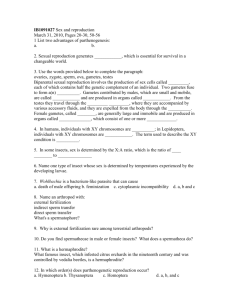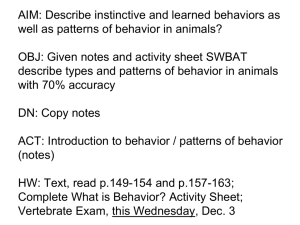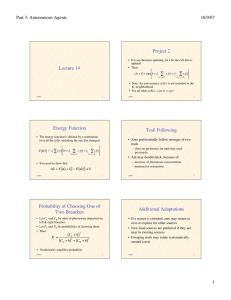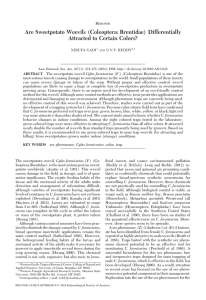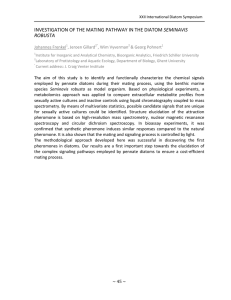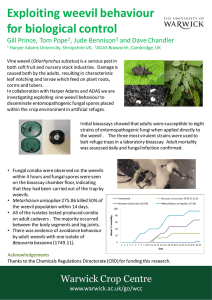Efficacy of Pheromone Trapping of the Sweetpotato Weevil
advertisement
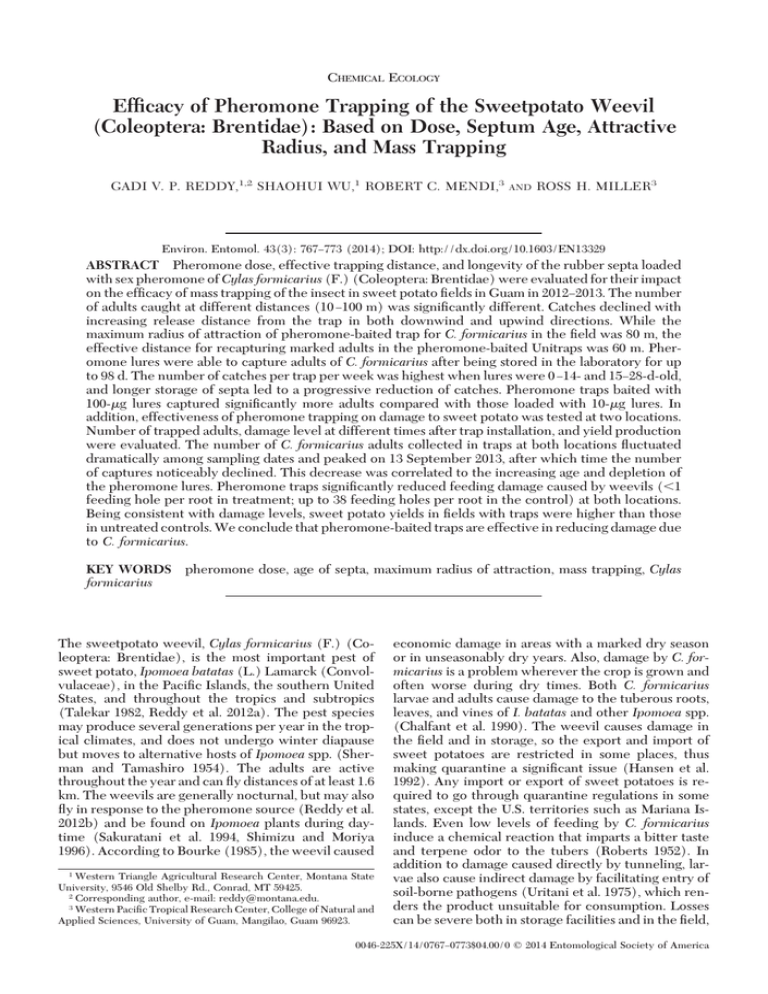
CHEMICAL ECOLOGY Efficacy of Pheromone Trapping of the Sweetpotato Weevil (Coleoptera: Brentidae): Based on Dose, Septum Age, Attractive Radius, and Mass Trapping GADI V. P. REDDY,1,2 SHAOHUI WU,1 ROBERT C. MENDI,3 AND ROSS H. MILLER3 Environ. Entomol. 43(3): 767Ð773 (2014); DOI: http://dx.doi.org/10.1603/EN13329 ABSTRACT Pheromone dose, effective trapping distance, and longevity of the rubber septa loaded with sex pheromone of Cylas formicarius (F.) (Coleoptera: Brentidae) were evaluated for their impact on the efÞcacy of mass trapping of the insect in sweet potato Þelds in Guam in 2012Ð2013. The number of adults caught at different distances (10 Ð100 m) was signiÞcantly different. Catches declined with increasing release distance from the trap in both downwind and upwind directions. While the maximum radius of attraction of pheromone-baited trap for C. formicarius in the Þeld was 80 m, the effective distance for recapturing marked adults in the pheromone-baited Unitraps was 60 m. Pheromone lures were able to capture adults of C. formicarius after being stored in the laboratory for up to 98 d. The number of catches per trap per week was highest when lures were 0 Ð14- and 15Ð28-d-old, and longer storage of septa led to a progressive reduction of catches. Pheromone traps baited with 100-g lures captured signiÞcantly more adults compared with those loaded with 10-g lures. In addition, effectiveness of pheromone trapping on damage to sweet potato was tested at two locations. Number of trapped adults, damage level at different times after trap installation, and yield production were evaluated. The number of C. formicarius adults collected in traps at both locations ßuctuated dramatically among sampling dates and peaked on 13 September 2013, after which time the number of captures noticeably declined. This decrease was correlated to the increasing age and depletion of the pheromone lures. Pheromone traps signiÞcantly reduced feeding damage caused by weevils (⬍1 feeding hole per root in treatment; up to 38 feeding holes per root in the control) at both locations. Being consistent with damage levels, sweet potato yields in Þelds with traps were higher than those in untreated controls. We conclude that pheromone-baited traps are effective in reducing damage due to C. formicarius. KEY WORDS pheromone dose, age of septa, maximum radius of attraction, mass trapping, Cylas formicarius The sweetpotato weevil, Cylas formicarius (F.) (Coleoptera: Brentidae), is the most important pest of sweet potato, Ipomoea batatas (L.) Lamarck (Convolvulaceae), in the PaciÞc Islands, the southern United States, and throughout the tropics and subtropics (Talekar 1982, Reddy et al. 2012a). The pest species may produce several generations per year in the tropical climates, and does not undergo winter diapause but moves to alternative hosts of Ipomoea spp. (Sherman and Tamashiro 1954). The adults are active throughout the year and can ßy distances of at least 1.6 km. The weevils are generally nocturnal, but may also ßy in response to the pheromone source (Reddy et al. 2012b) and be found on Ipomoea plants during daytime (Sakuratani et al. 1994, Shimizu and Moriya 1996). According to Bourke (1985), the weevil caused 1 Western Triangle Agricultural Research Center, Montana State University, 9546 Old Shelby Rd., Conrad, MT 59425. 2 Corresponding author, e-mail: reddy@montana.edu. 3 Western PaciÞc Tropical Research Center, College of Natural and Applied Sciences, University of Guam, Mangilao, Guam 96923. economic damage in areas with a marked dry season or in unseasonably dry years. Also, damage by C. formicarius is a problem wherever the crop is grown and often worse during dry times. Both C. formicarius larvae and adults cause damage to the tuberous roots, leaves, and vines of I. batatas and other Ipomoea spp. (Chalfant et al. 1990). The weevil causes damage in the Þeld and in storage, so the export and import of sweet potatoes are restricted in some places, thus making quarantine a signiÞcant issue (Hansen et al. 1992). Any import or export of sweet potatoes is required to go through quarantine regulations in some states, except the U.S. territories such as Mariana Islands. Even low levels of feeding by C. formicarius induce a chemical reaction that imparts a bitter taste and terpene odor to the tubers (Roberts 1952). In addition to damage caused directly by tunneling, larvae also cause indirect damage by facilitating entry of soil-borne pathogens (Uritani et al. 1975), which renders the product unsuitable for consumption. Losses can be severe both in storage facilities and in the Þeld, 0046-225X/14/0767Ð0773$04.00/0 䉷 2014 Entomological Society of America 768 ENVIRONMENTAL ENTOMOLOGY where yield losses due to C. formicarius may range from 60 to 97% (Jansson et al. 1987, Ray and Ravi 2005, Reddy et al. 2012a). The development of improved control methods is hampered because the immature life stages of C. formicarius generally go unnoticed. Eggs are laid in cavities just below the skin of the root (Sutherland 1986). Larvae are cryptic in nature and can complete their life cycles in either tubers or vines (Strong 1983). Traditionally, broad-spectrum insecticide applications are employed to manage C. formicarius. The below-ground feeding habits of the larvae and the nocturnal activities of the adults force growers to apply insecticides several times during the cropping season (Hwang 2000). Leng and Reddy (2012) reported that ecofriendly neem and spinosad may replace broad-spectrum synthetic neurotoxins for controlling C. formicarius. However, these chemicals are not readily available in the PaciÞc Islands. Limited work on using natural enemies has been performed (Chalfant et al. 1990), but has not yet been proven to provide effective control. Synthetic pheromones are important components of integrated pest management programs for many insect pests (Reddy and Guerrero 2004, 2010). The pheromone for C. formicarius was isolated from female weevils and bioassayed in the laboratory (Coffelt et al. 1978). Heath et al. (1986) puriÞed the active component, identiÞed it as (Z)-3-dodecen-1-ol (E)-2butenoate, and described a synthesis of the compound. The synthesis, formulation, and the Þeld use of pheromones to manage C. formicarius have been reported by various workers (Jackson and Bohac 2006, Sureda et al. 2006). Pheromone traps have great potential for monitoring C. formicarius (Proshold et al. 1986). Hwang (2000) demonstrated a practical and inexpensive pheromone trapping method for C. formicarius. Furthermore, an integrated approach using pheromone-baited traps with soil insecticides in Taiwan has shown promise (Hwang and Hung 1991, 1994). These studies support the use of sex pheromones as a potential tool for monitoring C. formicarius (Reddy et al. 2012b). However, traps used for monitoring alone do not provide effective control of C. formicarius under substantial crop damage levels (Talekar 1988, 1991). Considerable work has been done in improving the trapping efÞcacy (Jackson and Bohac 2006, Reddy et al. 2012b, Gadi and Reddy 2014). According to these studies, the effectiveness of trapping might be improved by combining the traps with other components. For example, our previous study suggested that pheromone-baited light red (chromameter values: L ⫽ 50.03; a ⫽ 47.6; b ⫽ 28.7; chroma ⫽ 55.6; and hue angle ⫽ 31.16) Unitraps (13 by 17.5 cm) installed 50 cm above the crop canopy effectively improved the C. formicarius adult catches and were recommended to use in mating, attract-and-kill, and eradication programs (Reddy et al. 2012b). Also, in our previous study, C. formicarius was found to prefer light red to other tested colors, and light red Unitraps with pheromone lures caught signiÞcantly Vol. 43, no. 3 more adults than identical traps without pheromone lures, suggesting that behaviors of C. formicarius were inßuenced by both visual and olfactory cues (Reddy et al. 2012b). Gadi and Reddy (2014) reported that green pheromone-baited Unitraps signiÞcantly attracted more C. formicarius than other colors in indoor situations (Gadi and Reddy 2014), whereas light red Unitraps are outperformed in the Þeld (Reddy et al. 2012b). As a part of ongoing efforts to develop effective pheromone-based trapping techniques for C. formicarius, additional studies were undertaken to investigate the effects of pheromone dose, septum age, and maximum radius of attraction on the efÞcacy of pheromones in mass trapping of C. formicarius in the sweet potato Þelds. Materials and Methods Pherocon Unitraps baited with lures (Reddy et al. 2012b) were used to trap adult C. formicarius in sweet potato Þelds in Inarajan and Yigo (Guam). Trapped adults were taken to the laboratory, placed in small groups in collapsible cages (12 by 10 by 10 cm), and fed with sweet potato leaves and pieces of tubers. Fresh sweet potato plant materials were supplied weekly. The colony was maintained at 22 ⫾ 2⬚C, 70 Ð 80% relative humidity, and a photoperiod of 16:8 (L:D) h. The insects were reared in the laboratory beginning in 2011. All adult insects used in experiments were 3Ð 4-wk-old, and had been reared for multiple generations with sweet potato tubers in the laboratory colony established in 2011. Fresh tubers were provided at 2Ð3-wk intervals during the rearing period. Pherocon Unitraps, frequently called bucket traps, (20.5 cm in height by 13 cm in diameter), were obtained from Trécé Incorporated (Adair, Oklahoma). Each Unitrap consisted of a funnel-shaped white plastic receptacle, with a yellow plastic lid and a holder in white color for attaching lures, mounted over a bucket to retain captured insects (Reddy et al. 2012b). Pheromone lures of 10 or 100 g of Z3-Dodecenyl-E2butenoate (purity of 90 Ð95%) in red standard rubber septa were obtained from AgBio Inc., Westminster, Colorado. Lures were stored in a sealed impermeable bag at 4⬚C until use. Lures were placed in a holder inside the bucket of the trap. Experiments were conducted in Guam at four locations: the University of Guam Agricultural Experiment Station in Yigo (13⬚ 31⬘ N, 144⬚ 52⬘ E, 139.5 m, a.s.l.), the Ija Experiment Station (13⬚ 26⬘ N, 144⬚ 48⬘ E, 74.98 m, a.s.l.), Dededo (13⬚ 30⬘ N, 144⬚ 51⬘ E, 96.9 m a.s.l.), and the Inarajan Experiment Station (13⬚ 15.259⬘ N, 144⬚ 43.300⬘ E, 35.052m, a.s.l.). In addition, morning glory, Ipomoea triloba (L.) (Convolvulaceae), which is a major alternative host for C. formicarius (Austin et al. 1991), was present on most study sites. Daily temperatures during the experiments ranged from 30.7 to 32.2⬚C. Maximum Radius of Attraction of the Pheromone Septum. The effective range of capture, the optimum distance, and maximum radius of attraction of the June 2014 REDDY ET AL.: TRAPPING OF SWEETPOTATO WEEVIL pheromone septa were determined using Unitraps baited with a septum loaded with 10 g of C. formicarius sex pheromone. This dose was chosen because of the manufacturerÕs decision and recommendation and also because further increase in dose would not affect the trapping distance. This experiment was carried out in sweet potato Þelds at the Yigo, Inarajan, and Ija experiment stations. Adult weevils used in these experiments were obtained from the laboratory culture. Using a camelÕs hair brush, weevils were marked on the thorax using different colors to indicate release direction and distance from the trap. Forty marked male adults were released in the late afternoon at 10, 20, 30, 40, 50, 60, 70, 80, 90, and 100 m from a Unitrap baited with a lure that was positioned 100 cm above the crop. Four releases with different colors were made as replicates at the same time in both downwind and upwind directions from the trap. Wind direction at release was determined by observing the ßag blowing pattern. Marked adults captured in the traps were counted in the morning following release. Effect of Aging of Septa on Weevil Capture. Field trials were carried out at the same sites from October 2012 to January 2013 to compare the attractiveness of traps equipped with septa loaded with 10 g of C. formicarius sex pheromone and exposed for varying periods. This experiment was replicated four times at each of the three locations. Freshly prepared septa previously exposed in the laboratory for 0, 14, 28, 42, 56, 70, 84, 98, and 112 d were evaluated for the same period in the Þeld. Septa were changed at 14-d intervals in each treatment, such that throughout the trapping period of the test, there were traps containing septum ranging from 0 to 112-d-old. Traps were rotated every week to avoid possible location effects. The number of marked adults caught in each trap was recorded weekly for 18 wk. Effect of Pheromone Dose Loaded in Septa on Weevil Capture. Unitraps were deployed at the same sites used previously and were baited with lures loaded with 0, 10, or 100 g of the sex pheromone. These doses were suggested and recommended by the manufacturer. Traps were checked from February to May 2013. Traps were rotated every week so that each trap appeared at each place for a 1-wk period. Adults caught in each trap were recorded and removed on a weekly basis for 17 wk. Effectiveness of Adult Weevil Trapping on Damage to Sweet Potato. Experiments to determine if pheromone-baited traps can reduce the damage caused by C. formicarius and increase the yield levels were conducted from June to September 2013. Twenty-Þve Unitraps equipped with 100 g of C. formicarius sex pheromone were installed in each of the 1,012-m2 sweet potato Þelds at Yigo and Inarajan. Sweet potato Þelds without pheromone traps at Dededo and Ija served as experimental controls. The distance between the trapping and control locations was ⬇40 km, while the intertrap distance was 60 m. Traps were randomized each week at each location to avoid any location effect. All adult weevils captured in each trap were counted and removed from the trap on a weekly 769 basis for 17 wk. Also, damage to roots (tubers) at each site was evaluated by randomly selecting eight roots from throughout the Þeld and counting the number of feeding holes. The yield of sweet potato measured by tuber weight was recorded in each Þeld site. Damage levels and yields from the treatment and control Þelds were compared to evaluate the effectiveness of pheromone traps in reducing damage from C. formicarius. Statistical Analysis. Data from the pheromone dose, septum age, and maximum radius of attraction were separately analyzed using the generalized linear mixed model procedure with SAS version 9.13 (SAS Institute 2009, Cary, NC). The random factor was the variation among replicates in each treatment. Because all response variables used were counts, a one-way Poisson ANOVA model was Þtted using the GLIMMIX Procedure SAS version 9.3 (SAS Institute 2009). A least square means test was used to make multiple comparisons of differences between treatments. The number of weevils collected in the mass-trapping experiment was analyzed using a two-way ANOVA to test for signiÞcant differences among different sampling periods in repeated measures and locations. In addition, a two-way ANOVA was used to test for differences in damage reduction among sampling dates and treatments, as well as differences among sampling dates and locations with or without pheromone traps installed. Differences were considered to be signiÞcant if P ⱕ 0.05. Results Maximum Radius of Attraction of the Pheromone Septum. The traps placed at 10 Ð100 m from the point of release caught 98 Ð100% of all marked adults released in a downwind direction. Similarly, 92Ð95% adults released in an upwind direction were captured. Catches declined with increasing release distance from the trap in both downwind and upwind directions. When marked adults were released 60 m from Fig. 1. Marked C. formicarius released at different distances from the pheromone source. Different letters indicate signiÞcant differences among treatments (one-way ANOVA with Poisson model, least square means, P ⱕ 0.05). Data were represented by means (⫾SE) of the marked adults (n ⫽ 40) that were released at each distance. 770 ENVIRONMENTAL ENTOMOLOGY Fig. 2. Mean catches of C. formicarius in pheromone traps baited with septa aged for different periods. Different letters indicate signiÞcant differences among treatments (one-way ANOVA with Poisson model, least square means, P ⱕ 0.05). Bars represent means (⫾SE) of 12 replicates (4 replicates per location ⫻ 3 sites). (Online Þgure in color.) the pheromone source, 78% of the adults were caught in the downwind release, whereas 54% of the adults were caught in the upwind release. The number of adults caught at different distances was signiÞcantly different (F ⫽ 12.23; df ⫽ 9, 80; P ⱕ 0.05; Fig. 1), and most adult weevils were recovered within a radius of 60 m. Traps on the downwind side of the release points caught more adults than the traps set up on the upwind side of the release points. Although the maximum radius of attraction was 80 m, the effective distance for recapturing marked adults in the pheromone-baited Unitraps was 60 m. Effect of Aging of Septa on Weevil Capture. Results suggest that the pheromone lures were able to capture adults of C. formicarius after being stored in the laboratory for up to 98 d, but there was a progressive reduction in the number of adults being caught as lures aged. The number of catches per trap per week was highest when the lures were 0 Ð14- and 15Ð28-dold, after which catches declined signiÞcantly (F ⫽ 2.97; df ⫽ 7, 26; P ⱕ 0.05; Fig. 2). Therefore, we recommend changing lures every 30 d to maximize attraction to the weevils. Vol. 43, no. 3 Fig. 4. Mean number of C. formicarius collected in traps on different sampling dates at two locations: Yigo and Inarajan. (Online Þgure in color.) Effect of Pheromone Dose Loaded in Septa on Weevil Capture. Traps baited with septa containing 100 g of attractant caught more C. formicarius adults than those baited with septa containing 10 g of attractant at all tested locations (Fig. 3), with signiÞcant differences observed between them (F ⫽ 11.26; df ⫽ 2, 97; P ⱕ 0.05). Traps without lures did not catch any adults. Effectiveness of Adult Weevil Trapping on Damage to Sweet Potato. At both locations, the number of C. formicarius adults collected in traps ßuctuated dramatically among sampling dates in repeated measures during the 4-mo duration of the experiment, ranging from 30.2 ⫾ 5.6 to 1515.6 ⫾ 57.8 per trap in Yigo and from 28.1 ⫾ 4.9 to 1497.6 ⫾ 68.5 per trap in Inarajan (Fig. 4). SigniÞcant differences in the number of C. formicarius were observed among sampling dates (F ⫽ 283.26; df ⫽ 16; P ⬍ 0.0001), but not between the two locations (F ⫽ 0.08; df ⫽ 1; P ⫽ 0.7739). No signiÞcant interaction between sampling date and location was found (F ⫽ 0.02; df ⫽ 16; P ⫽ 1.000). The peak adult trap capture occurred on 13 September 2013, after which time the number of captures noticeably declined. This decrease was correlated to the increasing age and depletion of the pheromone lures. Fig. 3. Mean cumulative C. formicarius adults caught in pheromone traps baited with 0, 10, or 100 g pheromone per septum. Different letters indicate signiÞcant differences among treatments (one-way ANOVA with Poisson model, least square means, P ⱕ 0.05). Bars represent means (⫾SE) of 12 replicates (4 replicates per location ⫻ 3 sites). (Online Þgure in color.) June 2014 REDDY ET AL.: TRAPPING OF SWEETPOTATO WEEVIL 771 Fig. 5. Mean number of feeding holes per root (tuber) caused by C. formicarius in Þelds with pheromone-baited traps and in the control with no pheromone traps at two Þeld locations: Yigo and Inarajan (Trapping); Dededo and Ija (Control), on different sampling dates. The effect of traps in reducing the damage caused by C. formicarius, damaging holes in the treatment with traps, and the untreated control was assessed over time at two different locations. SigniÞcant differences were observed between the trap treatment and the control (F ⫽ 5793.36; df ⫽ 1; P ⬍ 0.0001), among sampling dates (F ⫽ 123.39; df ⫽ 16; P ⬍ 0.0001), and there was signiÞcant interaction between treatment and sampling dates (F ⫽ 128.45; df ⫽ 16; P ⬍ 0.0001; Fig. 5). Root damage in the treatment with traps was consistently low (⬍1 feeding hole per root) over the 4-mo duration of the experiment. There were no signiÞcant differences observed between Þeld locations in Þelds with traps installed (F ⫽ 1.22; df ⫽ 1; P ⫽ 0.2707), among sampling dates (F ⫽ 1.56; df ⫽ 16; P ⫽ 0.0814), or in the interaction of sampling date and location (F ⫽ 0.34; df ⫽ 16; P ⫽ 0.9922). However, root damage levels in the control were high at both locations (up to 38 feeding holes per root); and there were signiÞcant differences in damage among sampling dates (F ⫽ 129.33; df ⫽ 16; P ⬍ 0.0001), but not between locations (F ⫽ 0.86; df ⫽ 1; P ⫽ 0.354). No signiÞcant interaction between sampling date and location was observed in the untreated control (F ⫽ 1.14; df ⫽ 16; P ⫽ 0.3163). The present results indicate that pheromone-baited traps are effective in reducing the weevil numbers and the damage due to C. formicarius. Sweet potato yields in Þelds treated with traps were higher than in the untreated control, averaging 14.59 T/ha at Yigo and 13.47 T/ha at Inarajan in the trapped area, compared with 8.26 T/ha at Dededo and 7.86 T/ha at Ija in the control. Discussion The use of pheromone traps is a promising approach for monitoring and controlling C. formicarius (Jackson and Bohac 2006). However, the successful and practical use of pheromones requires an understanding of parameters such as pheromone dose, lure longevity, timing of lure replacement, and the maximum radius of attraction. From such information the best arrangement of traps and the optimal number of traps to be installed may be estimated. Factors such as wind velocity, weevil population density, and the availability of Ipomoea species in the intermediate area must also be considered when designing the trapping scheme. The current study indicates that the effective distance for recapturing the marked adults in the pheromone-baited Unitraps was 60 m, even though the maximum radius of attraction of a septum containing 10 g of C. formicarius attractant was 80 m (Fig. 1). However, when Sugimoto et al. (1994) used lures with the higher dosage of 100 and 400 g in their study in Japan, the average distance for capturing C. formicarius was only 55 and 64 m, respectively. The number of adults caught in traps differed in the current study when marked adult weevils were released in the downwind or upwind direction. Jansson et al. (1991) reported that males of C. formicarius were recaptured from all released directions with similar frequencies at night when wind direction varied considerably. Differences in the number of recaptured C. formicarius between upwind and downwind directions observed in this study may be explained by changes in the pheromone diffusion pattern associated with the prevailing wind direction. Impact of wind direction on captures of C. formicarius was also observed by Sugimoto et al. (1994). The selection of the appropriate dose of pheromone in lures is critical for monitoring and controlling insect pests. The current study clearly indicated that a dose of 100 g doubled the number of catches compared with a dose of 10 g (Fig. 3). In previous reports, the response threshold dose for C. formicarius was ⬇10 g per septum (Jansson et al. 1991), and was shown to be adequate for monitoring weevils in sweet potato Þelds (Reddy et al. 2012b). However, Jansson et al. (1991) suggested that higher dosages would likely be required for mass trapping or mating disruption applications. Previous studies have shown a positive relationship between trap captures and pheromone dosages ranging from 10 ng to 1 mg (Proshold et al. 772 ENVIRONMENTAL ENTOMOLOGY 1986, Mason and Jansson 1990). However, the success of mass trapping is also dependent on the population trend in the Þeld, and trap counts were not consistently correlated with the pheromone dose at low population levels (Jansson et al. 1991). Effect of doses was not confounded in the current study, given the high densities of C. formicarius (up to 2,000 catches per trap per week). Results from this study also suggest that the pheromone lures were still able to capture C. formicarius adults after 98 d of laboratory storage, but were most effective within 28 d, and trap catches decreased the longer the septa were stored (Fig. 2). In India, pheromone lures for C. formicarius were used up to 90 d in the Þeld (Pillai et al. 1993), and in Florida, 60-d-old rubber septa with 10 g of pheromone performed as well as new lures (Mason and Jansson 1990). Jansson et al. (1991) reported that the sex pheromone of C. formicarius was moderately stable on rubber septa and that lures remained active for at least 30 Ð 64 d. However, Hwang (2000) showed that the effectiveness of lures declined after 60 d. Smit et al. (1997) reported that in Uganda, lures for the sweetpotato weevil species, Cylas puncticollis (Boheman) and Cylas brunneus (F.), showed no signiÞcant decline in attractiveness after 8 wk in the Þeld. In addition, Hwang (2000) recommended changing lures monthly, which was supported by our results. Effectiveness of mass trapping in reducing the damage caused by C. formicarius was evaluated at different locations in Guam with similar population trends before treatment, as indicated by Reddy et al. (2012a) that there was no population ßuctuation on the island of Guam, although there was a difference among different islands (Guam, Saipan, Rota, and Tinian). Mass trapping of C. formicarius not only reduced the infestation but also almost doubled the yield compared with that of control plots. Root damage in Þelds with traps was signiÞcantly lower (⬍1 feeding hole per root), compared with the damage level in Þelds without traps (up to 38 feeding holes per root; Fig. 5). Our observations clearly suggest that root damage may be signiÞcantly reduced by traps. This is the Þrst study on the mass trapping of C. formicarius demonstrating that the sex pheromone traps reduced the damage level and thereby increased yield of I. batatas in the PaciÞc Basin. Our results corroborate those of several studies carried out in different countries but in a different geographic area. For example, mass trapping using the pheromone suppressed populations of C. formicarius in Taiwan (Hwang and Hung 1991), India (Pillai et al. 1993), Japan (Yasuda 1995), and Indonesia (Braun and Van De Fliert 1999). In the Dominican Republic, the use of pheromone traps signiÞcantly reduced yield losses due to C. formicarius (Alvarez et al. 1996). The International Potato Center (CIP) is currently cooperating with several national programs to further explore the use of pheromone traps (CIP 1995). Overall, the pheromone-based trapping provided signiÞcant control of C. formicarius. Although similar studies have been conducted on sweetpotato weevils, they were on different species (C. puncticollis and C. Vol. 43, no. 3 brunneus; Smit et al. 1997). The current study clearly demonstrates how mass trapping would help in controlling this borer pest. Because there are not many control options, the current study is important and vital for the growers, and also helps further studies on mating disruption. Using pheromones for mating disruption is a promising potential alternative for controlling C. formicarius (Mason and Jansson 1990, 1991). The density of C. formicarius populations was noticeably decreased in pheromone-treated Þelds, possibly due to male sterile technique and mating disruption (Yasuda 1995). In future studies, we will focus on combining mass trapping or mating disruption with entomopathogenic fungi (Beauveria bassiana and Metarhizium brunneum) and nematodes (e.g., Steinernema carpocapsae, Steinernema kraussei, Steinernema feltiae, and Heterorhabditis bacteriophora) for widespread control or possible even local eradiation of this serious pest. Acknowledgments This project was supported by FY 2011 PaciÞc Islands AreaÐConservation Innovation Grants (PIAÐCIG) Program, Grant Agreement #69-9251-11-902 (Sweetpotato Weevil), The Natural Resources Conservation ServiceÐU.S. Department of Agriculture (NRCSÐUSDA). USDA is an equal opportunity provider and employer. We thank David M.H. Mantanona and Ray Gumataotao for their help in the Þeld, and Jan Meneley, AgBio Inc., 9915 Raleigh St., Westminster, Co 80031, for providing the pheromone lures used in the study. References Cited Alvarez, P., V. Escarraman, E. Gomez, A. Villar, R. Jimenez, O. Ortiz, J. Alcazar, and M. Palacios. 1996. Economic impact of managing sweetpotato weevil (Cylas formicarius) with sex pheromones in the Dominican Republic. pp. 83Ð94. In T Walker, and C Chrissman (eds.), Case studies of the economic impact of cip-related technology. International Potato Center, Lima, Peru. Austin, D. F., R. K. Jansson, and G. W. Wolfe. 1991. Convolvulaceae and Cylas: a proposed hypothesis on the origins of this plant/insect relationship. Trop. Agric. 68: 162Ð170. Bourke, R. M. 1985. Sweet potato (Ipomoea batatas) production and research in Papua New Guinea. PNG J. Agric. For. Fish 33: 3Ð 4. Braun, A. R., and E. Van De Fliert. 1999. Evaluation of the impact of sweetpotato weevil (Cylas formicarius) and of the effectiveness of Cylas sex pheromone traps at the farm level in Indonesia. Int. J. Pest Manage. 45: 101Ð110. Chalfant, R. B., R. K. Jansson, D. R. Seal, and J. M. Schalk. 1990. Ecology and management of sweet potato insects. Annu. Rev. Entomol. 35: 157Ð180. (CIP) International Potato Center. 1995. Program Report: 1993Ð1994. International Potato Center (CIP), Lima, Peru, p. 192. Coffelt, J. A., K. W. Vick, L. Sower, and W. T. McClellan. 1978. Sex pheromone of the sweetpotato weevil, Cylas formicarius elagantulus: Laboratory bioassay and evidence for a multiple component system. Environ. Entomol. 7: 756 Ð758. June 2014 REDDY ET AL.: TRAPPING OF SWEETPOTATO WEEVIL Gadi, N., and G.V.P. Reddy. 2014. Are sweetpotato weevils differentially attracted to certain colors? Ann. Entomol. Soc. Am. 106: 274 Ð278. Hansen, J. D., C. L. Emerson, and D. A. Signorotti. 1992. Visual detection of sweetpotato weevil by non-invasive methods. Fla. Entomol. 75: 369 Ð375. Heath, R. R., J. A. Coffelt, P. E. Sonnet, F. I. Proshold, B. Dueben, and J. H. Tumlinson. 1986. IdentiÞcation of sex pheromone produced by female sweetpotato weevil, Cylas formicarius elegantulus (Summers). J. Chem. Ecol. 12: 1489 Ð1503. Hwang, J. S. 2000. Integrated control of sweetpotato weevil, Cylas formicarius Fabricius, with sex pheromone and insecticide, pp. 25Ð 43, in C. Chien (ed.), Sweet Potato Production. Tsukuba, Ibaraki, Japan. Hwang, J. S., and C. C. Hung. 1991. Evaluation of the effect of integrated control of sweetpotato weevil, Cylas formicarius Fabricius, with sex pheromone and insecticide. Chin. J. Entomol. 11: 140 Ð146. Hwang, J. S., and C. C. Hung. 1994. Sweetpotato insect pest management and the application of sex pheromone, pp. 229 Ð245. In Proceedings of a Symposium on Root Crop Yield Improvement, Processing and Utilization in Taiwan. TARI Special Publication No. 45, Chiayi Agricultural Experiment Station, Chiayi, Taiwan, ROC. Jackson, D. M., and J. R. Bohac. 2006. Evaluation of pheromone traps for monitoring sweetpotato weevils. J. Agric. Urban Entomol. 23: 141Ð158. Jansson, R. K., H. H. Bryan, and K. A. Sorensen. 1987. Within vine distribution and damage of sweetpotato weevil, Cylas formicarius elegantulus (Coleoptera: Curculionidae), on four cultivars of sweetpotato in southern Florida. Fla. Entomol. 70: 523Ð526. Jansson, R. K., L. J. Maon, and R. R. Heath. 1991. Use of sex pheromone for monitoring and managing Cylas formicarius, pp. 97Ð138. In R. K. Jansson and K. V. Raman (eds.), Sweet potato pest management: A global perspective. Westview Press, Inc., Boulder, Colorado, p. 458. Leng, P. H., and G.V.P. Reddy. 2012. Bioactivity of selected eco-friendly pesticides against the sweetpotato weevil, Cylas formicarius (Fabricius) (Coleoptera: Brentidae), Fla. Entomol. 95: 1040 Ð1047. Mason, L. J., and R. K. Jansson. 1990. Potential of mass trapping and mating disruption for sweetpotato weevil management. Proc. Interam. Soc. Trop. Hort. 34: 89 Ð95. Mason, L. J., and R. K. Jansson. 1991. Disruption of sex pheromone communication in Cylas formicarius (Coleoptera: Apionidae) as a potential means of control. Fla. Entomol. 74: 469 Ð 472. Pillai, K. S., P. Rajamma, and M. S. Palaniswami. 1993. New technique in the control of sweet potato weevil using synthetic sex pheromone in India. Int. J. Pest Manage. 39: 84 Ð 89. Proshold, F. I., J. L. Gonzalez, C. Asencio, and R. R. Heath. 1986. A trap for monitoring the sweetpotato weevil (Coleoptera: Curculionidae) using pheromone or live females as bait. J. Econ. Entomol. 79: 641Ð 647. Ray, R., and V. Ravi. 2005. Post-harvest spoilage of sweetpotato in tropics and control measures. Crit. Rev. Food Sci. Nutr. 45: 623Ð 644. Reddy, G.V.P., and A. Guerrero. 2004. Interactions of insect pheromones and plant semiochemicals. Trends Plant Sci. 9: 253Ð261. Reddy, G.V.P., and A. Guerrero. 2010. New pheromones and insect control strategies. Vitam. Horm. 83: 493Ð519. 773 Reddy, G.V.P., J. McConnell, and A. E. Badilles. 2012a. Estimation of the population density of the sweetpotato weevils on the Mariana Islands. J. Entomol. Acarol. Res. 44: 18 Ð21. Reddy, G.V.P., N. Gadi, and A. J. Taianao. 2012b. EfÞcient sex pheromone trapping: catching the sweetpotato weevil Cylas formicarius. J. Chem. Ecol. 38: 846 Ð 853. Roberts, R. A. 1952. Sweetpotato weevil, pp. 527Ð553. In A. Stefferud (ed), U.S. Dep. Agric. Yearbook, Insects, Washington, DC. Sakuratani, Y., T. Sugimoto, O. Setokuchi, T. Kamikado, K. Kiritani, and T. Okada. 1994. Diurnal changes in microhabitat usage and behavior of Cylas formicarius (Fab.) adults. Appl. Entomol. Zool. 29: 307Ð315. SAS Institute. 2009. SAS/STAT userÕs guide, release 9.3, SAS Institute, Cary, NC. Sherman, M., and M. Tamashiro. 1954. Sweetpotato weevils in Hawaii and their biology and control. Hawaii Agric. Exp. Stn. Hawaii 23: 38. Shimizu, T., and S. Moriya. 1996. Flight time and ßight age in the sweetpotato weevil, Cylas formicarius (Fabricius) (Coleoptera: Brentidae). Appl. Entomol. Zool. 31: 575Ð 580. Smit, N.E.J.M., M.C.A. Downham, B. Odongo, D. R. Hall, and P. O. Laboke. 1997. Development of pheromone traps for control and monitoring of sweetpotato weevils, Cylas puncticollis and C. brunneus, in Uganda. Entomol. Exp. Appl. 85: 95Ð104. Strong, L. A. 1983. Report of the chief of the bureau of entomology and plant quarantine. United States Department of Agriculture, Washington, DC. Sugimoto, T., Y. Sakuratani, O. Setokuchi, T. Kamikado, K. Kiritani, and T. Okada. 1994. Estimations of the attractive area of pheromone traps and dispersal distance, of male adults of sweetpotato weevil, Cylas formicarius (Fabricius) (Coleoptera: Curculionidae). Appl. Entomol. Zool. 29: 349 Ð358. Sureda, T., C. Quero, M. P. Bosch, R. Aviles, F. Coll, M. Renou, and A. Guerrero. 2006. Electrophysiological and behavioral responses of a Cuban population of the sweet potato weevil to its sex pheromone. J. Chem. Ecol. 32: 2177Ð2190. Sutherland, J. A. 1986. A review of the biology and control of the sweetpotato weevil Cylas formicarius (Fab). Trop. Pest Manage. 32: 304 Ð315. Talekar, N. S. 1982. Effects of a sweetpotato weevil (Coleoptera: Curculionidae) infestation on sweet potato root yields. J. Econ. Entomol. 59: 1028 Ð1044. Talekar, N. S. 1988. How to control sweetpotato weevil: A practical IPM approach. AVRDC Publ. 88 Ð292, Taiwan, R.O.C., 6pp. Talekar, N. S. 1991. Integrated control of Cylas formicarius., pp. 139 Ð156. In R. K. Jansson and K. V. Raman (eds.), Sweet potato pest management: A Global Perspective. Westview Press, Inc., Boulder, CO. Uritani, I., T. Saito, H. Honda, and W.K.Kim. 1975. Induction of furano-terpenoids in sweet potato roots by the larval components of the sweet potato weevils. Agric. Biol. Chem. 37: 1857Ð1862. Yasuda, K. 1995. Mass trapping of the sweet potato weevil Cylas formicarius (Fabricius) (Coleoptera: Brentidae) with a synthetic sex pheromone. Appl. Entomol. Zool. 30: 31Ð36. Received 1 December 2013; accepted 10 March 2014.
